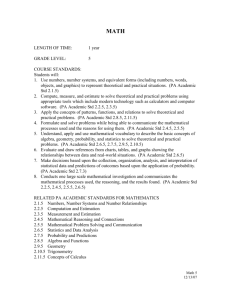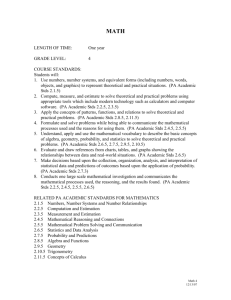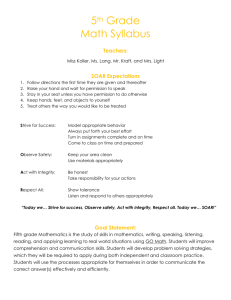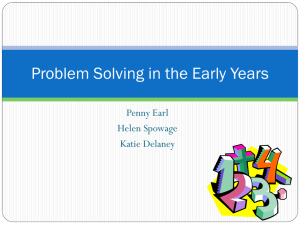Testing planned course doc - Palisades School District
advertisement
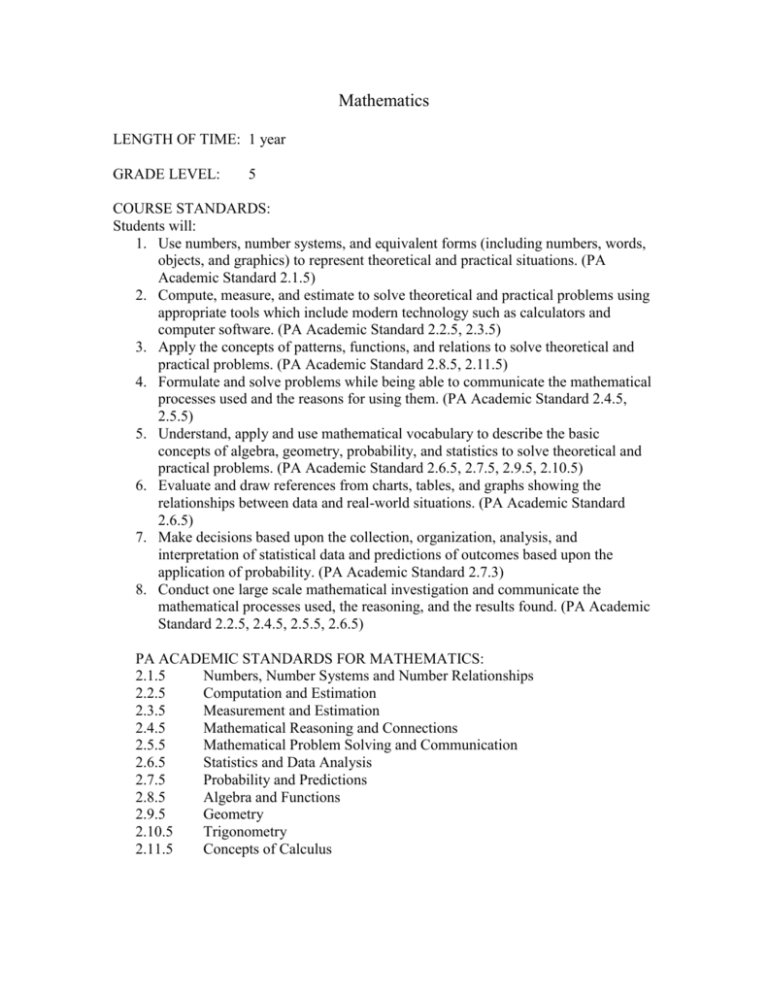
Mathematics LENGTH OF TIME: 1 year GRADE LEVEL: 5 COURSE STANDARDS: Students will: 1. Use numbers, number systems, and equivalent forms (including numbers, words, objects, and graphics) to represent theoretical and practical situations. (PA Academic Standard 2.1.5) 2. Compute, measure, and estimate to solve theoretical and practical problems using appropriate tools which include modern technology such as calculators and computer software. (PA Academic Standard 2.2.5, 2.3.5) 3. Apply the concepts of patterns, functions, and relations to solve theoretical and practical problems. (PA Academic Standard 2.8.5, 2.11.5) 4. Formulate and solve problems while being able to communicate the mathematical processes used and the reasons for using them. (PA Academic Standard 2.4.5, 2.5.5) 5. Understand, apply and use mathematical vocabulary to describe the basic concepts of algebra, geometry, probability, and statistics to solve theoretical and practical problems. (PA Academic Standard 2.6.5, 2.7.5, 2.9.5, 2.10.5) 6. Evaluate and draw references from charts, tables, and graphs showing the relationships between data and real-world situations. (PA Academic Standard 2.6.5) 7. Make decisions based upon the collection, organization, analysis, and interpretation of statistical data and predictions of outcomes based upon the application of probability. (PA Academic Standard 2.7.3) 8. Conduct one large scale mathematical investigation and communicate the mathematical processes used, the reasoning, and the results found. (PA Academic Standard 2.2.5, 2.4.5, 2.5.5, 2.6.5) PA ACADEMIC STANDARDS FOR MATHEMATICS: 2.1.5 Numbers, Number Systems and Number Relationships 2.2.5 Computation and Estimation 2.3.5 Measurement and Estimation 2.4.5 Mathematical Reasoning and Connections 2.5.5 Mathematical Problem Solving and Communication 2.6.5 Statistics and Data Analysis 2.7.5 Probability and Predictions 2.8.5 Algebra and Functions 2.9.5 Geometry 2.10.5 Trigonometry 2.11.5 Concepts of Calculus PERFORMANCE ASSESSMENTS: Students will demonstrate achievement of the standards by: 1. Completing unit tests with/without rubric. 2. Demonstration of the problem solving process with performance assessments. 3. Oral questioning and interviewing. 4. Self and peer assessment provided by Everyday Math curriculum. 5. Teacher observation at completion of task or activity. 6. Student portfolio to maintain student work. 7. Math journal, math messages. 8. Oral or written presentation to demonstrate a solution, concept, project, survey, etc. 9. Group and individual mathematical investigations. (Course Standard #8) 10. Free response questions with/without rubric. 11. Class and homework assignments. DESCRIPTION OF COURSE: The Everyday Math curriculum stresses the importance of the relationship between fundamental math skills and the application of such skills in complex problem solving. Students will engage in problem solving tasks using the skills outlines above and communicate effectively using mathematical language. Students will demonstrate number sense, reasoning abilities and problem-solving skills throughout the course. The instruction in this course will include, but not be limited to: numeration through the trillions, addition and subtraction with multi-digit whole numbers and decimals, extended multiplication and division problems, multiplication of multi-digit numbers, fractions, decimals and percents, converting fractions and mixed numbers, using the US customary and metric units, adding and subtracting fractions and decimals, identifying prime and composite numbers, calculating area and perimeter, collecting and interpreting data for analysis, predict, test, and summarize mathematical experiments, effectively use mathematical tools such as calculator, protractor, compass and computer to effectively solve math problems. UNITS OF STUDY/PACING COMPLETION: 1. Number Theory/ (Aug-mid Sept) 2. Estimation and Computation/(mid Sept-mid Oct) 3. Geometry Explorations and the American Tour/(mid Oct- mid Nov) 4. Division/(mid Nov- mid Dec) 5. Fractions, Decimals, and Percents/(mid Dec-mid Jan) 6. Using Data; Addition and Subtraction of Fractions/(mid Jan-mid Feb) 7. Exponents and Negative Numbers/(mid Feb-end Feb) 8. Fractions and Ratios/(end Feb-mid March) 9. Coordinates, Area, Volume, and Capacity/(mid March-beg. April) 10. Using Data; Algebra Concepts and Skills/ (beg. April- end April) 11. Volume/ (end April- mid/end May) 12. Probability, Ratios, and Rates/ (end May-June) SAMPLE INSTRUCTIONAL STRATEGIES: Teacher/student made activities Teacher/student led discussions and activities Problem solving performance tasks Calculators and computer software Individual and group explorations and investigations Games and manipulatives Written explanations Teacher/peer modeling Math Vocabulary word wall MATERIALS: 1. Everyday Mathematics: The University of Chicago School Mathematics Project, Everyday Learning Corporation, 2007, Chicago, Illinois. 2. Calculators, TI-15 3. Computers 4. Materials suggested by Everyday Math 5. Computer software, Everyday Math games 6. Math manipulatives 7. Base 10 blocks 8. Number lines and number grids 9. Reflective mirrors 10. Everyday Math Templates 11. Student reference books METHODS OF ASSISTANCE AND ENRICHMENT: Assistance: 1. Re-teaching with alternative strategies 2. Extended instructional time 3. Cooperative groups 4. Peer helpers 5. Recess reinforcement time with teacher 6. IST 7. Volunteer tutors 8. Modified grouping and instruction 9. Differentiated grouping and instruction 10. Modified testing if needed Enrichment: 1. Enhanced curriculum 2. peer tutoring 3. Modified testing 4. Individual mathematical investigations and projects 5. IST 6. PAL 7. Differentiated grouping and instruction PORTFOLIO DEVELOPMENT: 1. Teacher/student assessments (Unit) 2. Math journals 3. Individual/group investigations, projects, and/or activities 4. Written explanation of problem solving performance tasks 5. Pre/Mid/Post grade-level district assessment METHODS OF EVALUATION: 1. Pre/Mid/Post grade-level district assessments 2. Written Unit assessments (Everyday Math) 3. Problem Solving Performance tasks 4. Written and Oral presentations 5. Investigations, projects, and/or journals 6. Recognizing student achievement checklists (Everyday Math)
